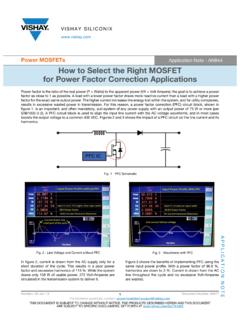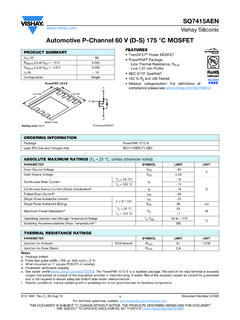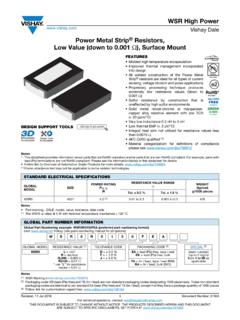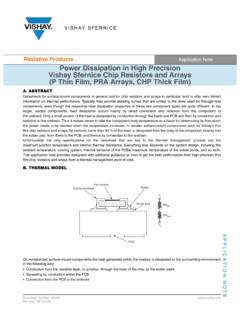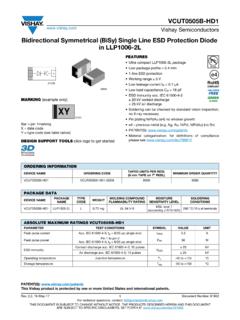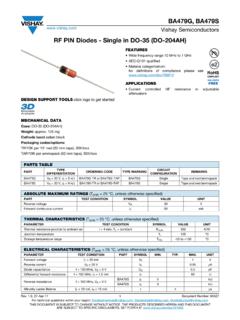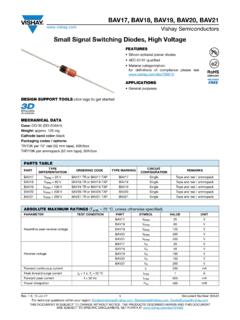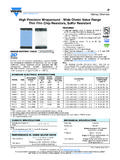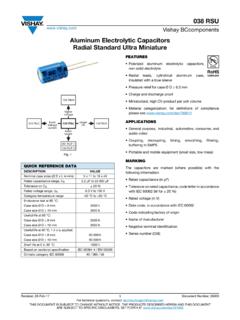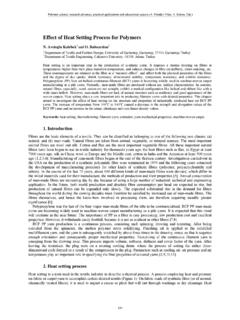Transcription of Designing With the PLA51 Planar Transformer for Enhanced ...
1 vishay SFERNICET ransformersApplication NoteDesigning With the PLA51 Planar Transformerfor Enhanced power density and NOTE Revision: 14-Jul-171 Document Number: 59063 For technical questions, contact: DOCUMENT IS SUBJECT TO CHANGE WITHOUT NOTICE. THE PRODUCTS DESCRIBED HEREIN AND THIS DOCUMENTARE SUBJECT TO SPECIFIC DISCLAIMERS, SET FORTH AT Sebastien Marchio1. GENERAL DEFINITIONN owadays, with the emergence of new technologies like electrical vehicles and renewable energy, the need to develop power converters has quickly grown. Designers are looking for Enhanced power density and efficiency, as well as smaller dimensions and lower weight. A rise in switching frequencies is suited to meeting this target, but leads to other constraints that need to be managed in the design of magnetic components, such as proximity and skin effects.
2 The main challenges with magnetic components are to minimize power losses and improve thermal PLA51 is a tropicalized Planar Transformer designed for converters from 1 kW to 3 kW. More compact than conventional transformers , the device's Planar technology allows it to achieve better efficiency while providing a high power to size ratio. With the highly effective cross section of the Planar ferrite core, the number of turns is minimized, as are the copper losses, while the magnetic core's low volume helps reduce core losses. The stacking of thin copper foil windings minimizes the influence of skin and proximity effects, while allowing for low leakage inductance addition, compared to conventional technology, Planar technology is better suited to heatsink-cooled devices. With the extended surface of the core and flatter shape, it offers high contact areas to improve heat dissipation by conduction, thus increasing the transferable power density .
3 The PLA51 can also withstand high temperatures because its insulation materials are rated to class H 180 C. On the other hand, the core of the PLA51 - which envelops all the windings - works as a natural shield to limit radiation emissions and avoid EMI / EMC ELECTRICAL PARAMETER DEFINITIONSIn converters, the purpose of transformers is to forward energy while providing the galvanic insolation between a primary and secondary grid, and to adapt voltage and current levels through the ratio. An electrical model of a power Transformer with the location of its different parameters is shown :-Rprim = primary winding resistance-Rsec = secondary winding resistance-LM = mutual inductance -Lleak-prim = primary leakage inductance-Lleak-sec = secondary leakage inductance-Rcore = core losses This model is often simplified as in the following diagram, where the leakage inductances are gathered as one on the primary side (Lleak).
4 The main electrical parameters for power Planar transformers are defined below. Unless otherwise indicated, the parameters are under VRMS and 10 InductanceThe primary inductance is the inductance value measured between primary winding reflects the sum of the magnetic flux shared between the primary and secondary windings and the primary leakage fluxshared betweenprimary andsecondary windingSecondary leakagefluxPrimary leakage fluxSecondarywindingFerrite corePrimarywindingRprimLleak-primRatioLl eak-secRsecRcoreLMRprimLleakRatioRsecRco reLMDesigning With the PLA51 Planar Transformerfor Enhanced power density and EfficiencyApplication SferniceAPPLICATION NOTE Revision: 14-Jul-172 Document Number: 59063 For technical questions, contact: DOCUMENT IS SUBJECT TO CHANGE WITHOUT NOTICE. THE PRODUCTS DESCRIBED HEREIN AND THIS DOCUMENTARE SUBJECT TO SPECIFIC DISCLAIMERS, SET FORTH AT InductanceThe leakage inductance of one winding reflects the magnetic flux, which is not shared with the other windings.
5 The measurement is carried out between the terminals of the winding while shunting the terminals of the other windings. For direct power transmission (forward, bridge, push-pull, etc.), we often look to minimize the primary leakage inductance. So, the mutual inductance (reflecting the magnetic flux shared between the primary and secondary windings) can be considered as the primary specific converter topologies need an inductor in series with the primary windings of the Transformer to work. This inductor can be part of the Transformer and match its leakage inductance, saving an additional component. Clever solutions can be designed upon requestTurn RatioThe turn ratio reflects the ratio between the number of turns of the secondary and primary the hypothesis of a perfect Transformer (perfect coupling), the ratio can be seen as the ratio of instantaneous values of voltage or current, as defined TestOne of the main functions of the Transformer is to guarantee insulation between primary and secondary grids.
6 The main objective of the hipot test is to ensure that the construction rules for creepage and clearance distances have been met. The tester applies sinus wave voltage and measures the leakage current (designed for a 1 minute duration). The frequency could be 50 Hz or 60 Hz, depending on the equipment used (European or standard).The creepage distance is the shortest distance along the surface of a solid insulating material between two conductive parts. The clearance distance is the shortest distance in the air between two conductive TestThe measurement of the insulation resistance is non-destructive under normal test by applying a DC voltage with a lower amplitude than for the dielectric test, the insulation test provides a result expressed in k , M , G , or T.
7 This resistance indicates the quality of the insulation between two MAGNETIC PARAMETER DEFINITIONSThe PLA51 has been designed with a manganese and zinc (MnZn) ferrite core to achieve the highest efficiency in the frequency range from 50 kHz to 400 function of the magnetic core is to lead the magnetic a given core, the effective dimensions are those of a theoretical toroidal core with the equivalent magnetic the PLA51 , the effective core parameters of the ferrite are in the table main characteristics of the ferrite material to be followed to achieve the best performance of the Transformer are defined below: The flux density B must be kept below the threshold of the saturation flux density Bs = 410 mT (100 C) For the bipolar square wave voltage, the maximum flux density can be assessed with the formula:RatioNsecNprim------------=Ratio VsecVprim------------IprimIsec---------= =Conductor 1 Conductor 2 Creepage distanceClearance distanceInsulatorSYMBOLDESCRIPTIONVALUEU NITleEffective path area351mm2 VeEffective volume25 4 x f x Nprimx Ae-------------------------------------- = Designing With the PLA51 Planar Transformerfor Enhanced power density and EfficiencyApplication SferniceAPPLICATION NOTE Revision: 14-Jul-173 Document Number: 59063 For technical questions, contact: DOCUMENT IS SUBJECT TO CHANGE WITHOUT NOTICE.
8 THE PRODUCTS DESCRIBED HEREIN AND THIS DOCUMENTARE SUBJECT TO SPECIFIC DISCLAIMERS, SET FORTH AT :- = maximum voltage applied to the primary winding-Nprim = number of turns of the primary winding-f (Hz) = switching frequency The core power losses can be assessed with the formula:Ploss = x 10-6 x (Bpeak) x (f) :-Ploss (W) = ferrite core power losses-Bpeak (T) = peak flux density -f (Hz) = switching frequencyNote Data are given for a core temperature of 100 CExample Primary input voltage = 50 V Switching frequency = 100 kHzNprim = 3 Bpeak = mT Ploss = W Primary inductance value: the inductance value is proportional to the square of the number of turns of the primary. It can be assessed with the following formula:L = AL x 10-9 x NWhere:-AL (nH) = inductance facto- For PLA51 , the AL = 14 230 nH/t2 25 % for an ungapped core -Other lower AL values carried out with a gapped core can be provided upon request-Nprim = number of turns of the primary windingExampleNprim = 3 L = 128 H Curie temperature: above the Curie temperature of 215 C, the material loses its magnetic properties.
9 The phenomenon is reversible4. WINDING RESISTANCE AND COPPER LOSSESThe winding resistance is an important parameter in evaluating the copper losses due to the current flow through the windings. Winding resistance can be calculated with the following formula:RDC = 20 C x Where:-RDC ( ) = winding resistance at 20 C- 20 C ( .m) = electrical resistivity of copper at room temperature-l (m) = length of the winding-A (m2) = cross section of the conductor used for the windingThe electrical resistance is dependent on the working temperature of the winding. For windings made of copper, the resistance at T temperature can be approximated with the following formula:R = RDC x [1 + x 10-3 (T - 20)]Where:-RDC ( ) = winding resistance at 20 C-R ( ) = winding resistance at working temperature-T ( C) = working temperatureExampleFor PLA51LA32: RDC (1-2) = m max.
10 (cannot be accurately measured) RDC (3-4) = m max. (cannot be accurately measured) R (1-2) = m R (3-4) = m With the increase of switching frequencies above 50 kHz, to 100 kHz, other phenomenon like skin and proximity effects become significant. Unlike DC current, with high frequencies the current density becomes higher at the edge of the conductor due to the appearance of eddy current inside the conductor, leading to a rise in effective AC CDC120 CDCD esigning With the PLA51 Planar Transformerfor Enhanced power density and EfficiencyApplication SferniceAPPLICATION NOTE Revision: 14-Jul-174 Document Number: 59063 For technical questions, contact: DOCUMENT IS SUBJECT TO CHANGE WITHOUT NOTICE. THE PRODUCTS DESCRIBED HEREIN AND THIS DOCUMENTARE SUBJECT TO SPECIFIC DISCLAIMERS, SET FORTH AT % of the current is concentrated within the external part of the conductor (the so-called skin).
